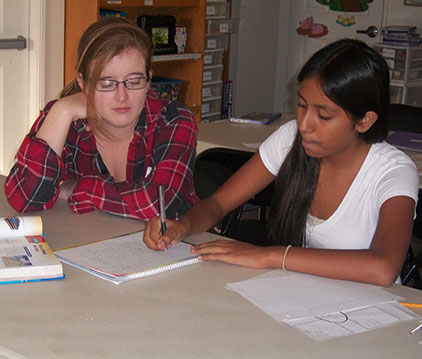Written by Cheyenne Bingham
 The first child I tried to work with during Homework Club spurned my quiet request to help him with his math homework. He glanced over at me suspiciously before slowly wrapping his arms around his homework, sinking over it like I had spied on something secret. Embarrassment burned through me, and I awkwardly walked back to the library, my usual hiding spot.
The first child I tried to work with during Homework Club spurned my quiet request to help him with his math homework. He glanced over at me suspiciously before slowly wrapping his arms around his homework, sinking over it like I had spied on something secret. Embarrassment burned through me, and I awkwardly walked back to the library, my usual hiding spot.
Before this, I had never worked with children before, not in any capacity. As the youngest child in my family, I was quiet, shy, and deeply introverted. The children of Villa Garcia, though friendly, were very daunting to me. The things they said and laughed at didn’t make sense, and I had a hard time asking if they needed any help.
Only 15 hours, I reminded myself. That was all I needed to pass my college course. Only 15 hours of volunteering. In 2012, badminton was all the rage with the kids of Villa Garcia. For a long stretch of time, we had enough adults to split up our students. I was one of them. The ones who had finished their homework could go outside and play badminton under the watchful eye of one staff and one adult volunteer. The rest would be supervised inside of the community by another staff and another adult volunteer.
One Thursday afternoon, one specific child was especially looking forward to this. He asked the coordinator about it twice before snack. Then, unexpectedly, our fourth adult got an emergency phone call and had to duck out. With only three adults on-site, we could not break up into groups. There would be no badminton match that day. Disappointed, the coordinator broke the news to the homework club. It was met with resigned groans and grumbling from the kids. But it was also met with a deeply saddened little boy. The child who’d eagerly asked about it just 20 minutes before stood alone in the middle of the room, shoulders hunched and eyes fixed on the ground. A silent tear ran down his face. When you’re five, disappointment is hard to swallow.
This child’s quiet devastation did not go unnoticed. Other children jumped up from their seats, immediately swarming him. They hugged him and patted his hair, promising that they would try again tomorrow. They tried making him laugh with silly jokes. They tried enticing him with board games. When none of that worked, they looked to each other and started firing out solutions over his bowed head.
“Can’t we just be supervised by one adult?” they asked. No, we told them. We explained it was for safety reasons.
“We can be safe,” they argued indignantly. We disagreed, memories of splinters, scraps, paper cuts, and bee stings dancing in our heads.
Undeterred, they went at it from a different angle. “How many kids had homework left?” they asked the rest of the room. Only three students raised their hands. “Couldn’t they finish outside while everyone else plays?”
That wasn’t fair to them, we reminded the kids. The community room had tables and supplies. If they finished homework outside, they needed to bring everything with them, and they would have to finish their assignments in their laps.
“But are they willing?” the kids asked.
Surprisingly, they were. The remaining students with homework even went as far to eagerly prove to us how little homework they had left. A worksheet here, a reading assignment there–in the face of such a united effort, we adults hesitated.
5 minutes later (and armed with our ubiquitous first aid backpack), we marched outside to the small patch of grass between two buildings. The net was quickly set up and the kids were split into teams. For one devastated child, it was like the last ten minutes had been easily erased. The game began, supervised and refereed by my coordinator. The children played joyously, giddy and laughing until program was over. As for me, I didn’t understand badminton. While they played, I sat down on the grass and helped a preteen through the rest of her algebra homework, my mind buzzing with all that had happened that afternoon.
There was a lot I didn’t know back then in 2012. First of all, I didn’t know I would eventually volunteer for 200 hours—well over my required 15. I didn’t know I would graduate from volunteer to intern to Children Services Assistant in just over a year, or that I would eventually move on within the company to grant writing.
I didn’t know the first child who refused my help has most contagious laughter I have ever heard, or that the upset five year would grow up to become a very polite and kind young man who always offers to help out. I didn’t know that I myself would become part of the Villa Garcia community, or that I would be greeted with hugs and invited to things like graduations, choir performances, and family events.
What I did know in 2012 was that the place that allowed such a strong, loving, and mutually supportive community grow was definitely a place I wanted to work at.
In 2020, I still don’t understand badminton, but because of what I saw at Villa Garcia, I do understand Many Mansions. Many Mansions provides housing. But Many Mansions also provides hope through services, resources, and opportunity. It creates safe spaces for residents to learn, grow, and bond with each other, developing a community. Many Mansions provides quality housing that residents can be proud of and services that support and uplift every participant.
I am proud of Many Mansions, and I am proud of the kids of Villa Garcia. To me, Villa Garcia will always be a shining example of what we mean when we say hope and housing.
